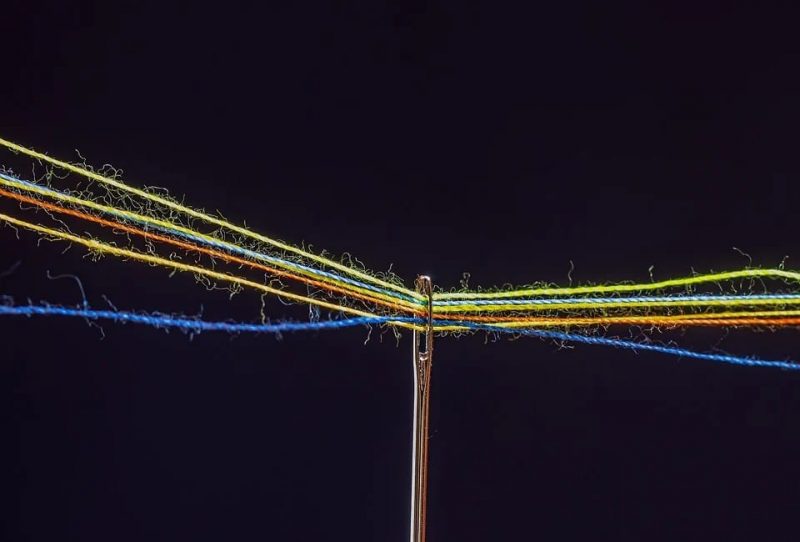It only takes two steps to master how to sew a pillow closed. It will be useful that you can close a pillow yourself to keep its filling protected. You can hand sew a pillow at home, but there might also come a time where you need to open your pillow and replace its stuffing.
Why does pillow closure matters? You want to protect the inside of your pillow to maintain its form and cleanliness. Knowing how to sew a pillow close will also let you experiment with different closure styles.

How To Sew A Pillow Closed By Hand
Step #1. Serging
This guide is an easy way to teach you how to close a pillow by hand-sewing. However, you’ll have a quicker time if you serge the bottom edges of the pillow first. Serging them will also help create a stronger pillow since the fabric edges will no longer fray after some time.
When you sew a pillow close, you can opt to hand stitch or use a sewing machine if it’s more comfortable. This guide only recommended using a serger, so you’ll have better quality pillows that can withstand the daily wear and tear.
Step #2. Stitching
Once you’ve serged the bottom edges, you can sew away from the bottom side’s fabric edges. This way, you can easily see where you’ll have the half-inch seam allowance. Then, stitch a small part on the right side of the pillow and another across it.
Continue sewing along the bottom edge, starting from right to left, and make a knot afterward. A useful way to close the pillow is with a ladder stitch because it is secured and relatively easy. But how do you sew a ladder stitch?
How to ladder stitch
For closing a pillow by hand, push your needle through one of the seams from back to front to hide the thread’s knotted end within the seam. Then, push the needle down and back up through the opposite seam to start your stitch hidden in the seam crease. At this point, you can repeat the process through the opposing seam crease.
After reaching the end, you want to pull your threaded needle to tighten the stitches. The ladder of connecting stitches should get concealed to achieve a tidy seam finish on the pillow. Finally, pick a tiny part of the seam opposite to where you emerge and thread through the loop to form a knot.
How To Sew A Pillow Closed By A Sewing Machine
Closing a pillow using a sewing machine is not that popular because placing a semi-finished pillow under the feed dogs is awkward. It’s more common to sew dense stitches and then double stitch the seam to strengthen the pillow’s closure. But if you must use a sewing machine, you must skip the part of leaving a gap in the seam and do other closure methods for the pillow instead.
Before using your sewing machine, inspect the bobbin area and if the presser foot is down. It would be best if you also threaded everything that needs threading to avoid hassle later on. Then, finish your pillow with an envelope-style closure.
There are different pillow closure techniques, but an envelope closure gives you the freedom to replace and remove the pillow insert quickly. This makes pillow cleaning more comfortable, and you can always use a new stuffing if your pillow loses its structure.
How To Make A Pillow With Envelope Closure
To start, you need to allocate a fabric flap around ¼ of the pillow’s width. You can cut the piece separately, stitch it, or simply use the extra material on your pillow fold to create a flap. Then, fold the wrong side half an inch and do the same on the pillow’s back panel.
You can make sewing easier by pinning the front and back pieces with their right sides and the hemmed edges of the back panels overlapping. Sew all around the pillow and cut corners diagonally. Finally, stitch the raw edges of the liner before turning it right side out.
You can always modify the envelope closure according to your liking. A common way to make the closure more secure is to add buttons. Sew them on one finished edge partnered by the holes on the other.
Conclusion
Making your own pillow is a fun way to create a customized one for you. However, it would help if you learned how to sew a pillow closed, so you’ll end up with a clean-looking seam, and the pillow won’t end up spilling the stuffing after daily use. A useful tip to prevent the fabric from fraying is to use a serger before finishing the pillow by hand-sewing a ladder stitch.
What if you want to use a sewing machine? In this case, you can opt for a different pillow closure style. An envelope closure would be more fitting because finishing a filled pillow gap under the sewing machine will be tricky.
If you don’t fancy a finished seam, you can always try other pillow closure techniques. For example, an envelope closure allows easy removal of the stuffing later on. You can use a sewing machine to stitch this closure style.
